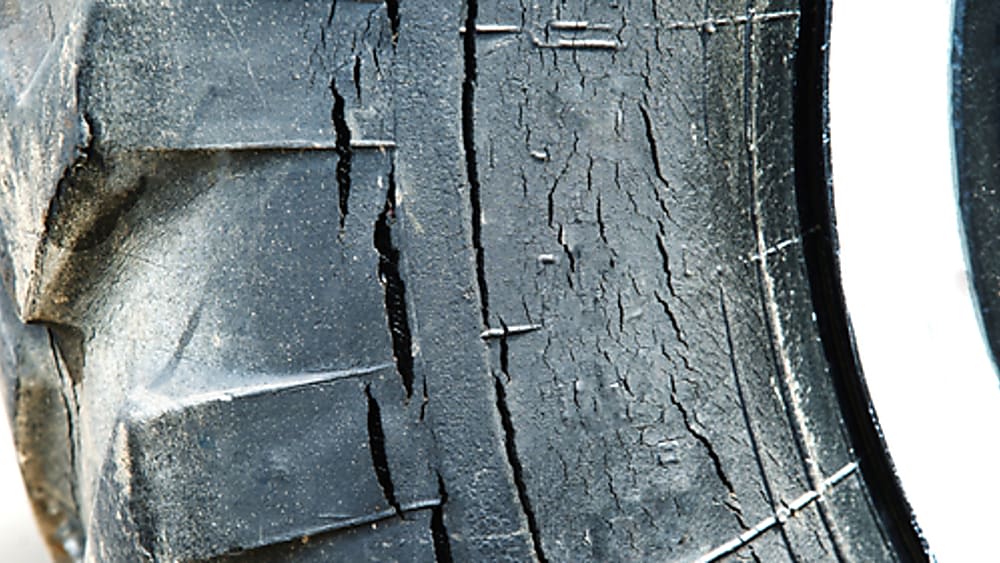Tire maintenance & safety
When do I need new tires? 5 ways to tell

Free shipping
Best price guarantee
SimpleCrew exclusive savings
0% financing options
Tire replacement coverage
24/7 roadside assistance
Easy returns
Tire maintenance & safety

Tires are the only point of contact between your vehicle and the road. They play a crucial role in ensuring your safety, handling, and overall driving performance. However, many vehicle owners often overlook the importance of regularly checking their tires for wear and damage.
Neglecting tire maintenance can lead to poor fuel efficiency, reduced traction, and even dangerous situations like blowouts or accidents. Knowing when it's time to replace your tires is essential for maintaining a safe and reliable vehicle.
In this article, we'll discuss five key indicators that signal it's time for new tires. By understanding these signs and performing simple checks, you can ensure your vehicle is always equipped with tires that provide optimal safety and performance.
The penny test is a quick, easy, and cost-effective way to check if your tire tread depth is sufficient for safe driving. Tread depth is crucial for maintaining proper traction, especially in wet or slippery conditions. Here's how to perform the penny test:
It's important to note that while the penny test is a helpful guideline, it's not a substitute for professional tire inspections. Tires should be replaced when the tread depth reaches 2/32" to ensure optimal safety and performance. Waiting until the tread is completely worn can lead to decreased traction, longer stopping distances, and an increased risk of hydroplaning—all of which can be dangerous, especially in adverse weather conditions.
In addition to the penny test, you can also check for tire wear bars, which are small raised bars located in the tire grooves. When the tread is flush with these indicators, it's a clear sign that your tires need to be replaced. By regularly monitoring your tire tread depth and replacing tires when necessary, you can maintain your vehicle's safety and avoid the risks associated with driving on worn-out tires.

Checking your tire sidewalls for signs of damage like cracks, cuts, or bulges is essential for ensuring your vehicle's reliability on the road. Damage in these areas can weaken the tire's overall structure, increasing the risk of unexpected failures. Often, such issues arise from impacts with road hazards, such as curbs or debris, which can compromise the tire's integrity.
Cracks in the sidewall might suggest that the rubber is aging or deteriorating, a common occurrence as tires get older. Bulges indicate a separation within the tire’s layers, where air has intruded, forming a weak spot. This condition can be particularly dangerous, as it may lead to a sudden blowout while driving.
If you detect any signs of sidewall damage, it's wise to consult a professional for a thorough evaluation. They can assess the severity of the damage and recommend whether a replacement is necessary. Addressing these issues without delay is crucial to maintaining safety and preventing potential tire failure on the road.
A tire pressure monitoring system (TPMS) light that frequently activates can indicate underlying issues that need attention. This light, when persistent, often points to a slow leak or inadequate tire pressure levels. Consistently low tire pressure can lead to uneven tread wear and negatively affect your vehicle's handling. Additionally, it may cause your car to consume more fuel because underinflated tires increase rolling resistance.
Driving with inadequate tire pressure has its risks. It can result in higher tire temperatures and cause the tire's structural components to degrade over time. This degradation increases the likelihood of a blowout. Furthermore, improper tire pressure compromises vehicle control, which is especially critical during adverse weather conditions. These factors highlight the necessity of resolving tire pressure concerns swiftly.
If your TPMS light remains illuminated despite regular inflation efforts, seeking professional advice is advisable. A detailed inspection can reveal whether the issue arises from a puncture, a malfunctioning valve stem, or internal tire damage. Addressing these concerns ensures that your tires continue to deliver reliable safety and performance.

Noticing unusual vibrations while on the road can be a sign that something's amiss with your tires. Such vibrations often suggest issues like a shifted belt or damaged cords within the tire. These problems may develop after driving over rough terrain or encountering road hazards, leading to an imbalance that manifests as vibrations felt in the steering wheel or through the seat.
Leaving these symptoms unchecked can escalate into more significant concerns. Internal tire damage can compromise stability, increasing the likelihood of a blowout or sudden loss of control. This danger is particularly heightened during high-speed driving or sudden stops. It's crucial to seek a thorough inspection to pinpoint the cause, whether it's related to the tires or other components like the suspension system.
Proactive tire maintenance and addressing any unusual signs promptly help ensure your vehicle remains safe and performs reliably. Regular inspections by a professional can prevent minor issues from becoming major safety risks.
Tires have a finite lifespan, and as they age, their internal materials begin to deteriorate. This breakdown, caused by exposure to sunlight, heat, and other environmental factors, can increase the risk of tire failure. While tread depth is often checked, it is vital to also consider the tire's age for overall safety.
To find out how old your tires are, locate the DOT code on the sidewall. This code provides the manufacturing date, with the last four digits indicating the week and year. For example, a code ending in "2518" signifies the tire was made in the 25th week of 2018. Evaluating tires over 6 years old is important, and those nearing 10 years typically require replacement, irrespective of tread condition.
Replacing older tires ensures your vehicle remains safe and performs well. As tires age, their ability to handle driving stresses diminishes, especially under challenging conditions or with heavy loads. By monitoring tire age, you can avoid unexpected failures and maintain a secure driving experience.
Monitoring your tires for these five warning signs is essential to ensure your vehicle's safety, performance, and longevity. If you notice any of these indicators, it's time to consider replacing your tires. At SimpleTire, we make it easy for you to find the perfect tires for your vehicle at the best prices, so you can shop for tires online and enjoy a seamless tire-buying experience from the comfort of your home.
Search By